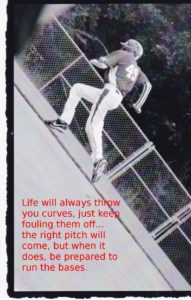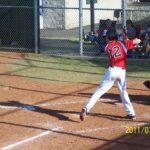Dropped third strike rule in youth baseball
I f you have listened to the discussions from the stands, or at local league coaches meetings, about dropped third strike rules and decisions in youth baseball, you may or may not know the dropped third strike rule.
Throw Harder..Impress
Increase Pitching Performance
You need to know the dropped third strike rule if you are coaching youth baseball, plus it is a fun rule to know. Some very exciting plays can happen as a result of this rule.
An interesting fact about the dropped third strike rule is according to MLB Rule 6.09 is actually an uncaught third strike. It has nothing to do with catcher dropping the ball. So where did the phrase “dropped third strike come from?” I have no idea, but the rule does actually state “The third strike called by the umpire is not caught,…” So, What is the dropped third strike rule?
Dropped Third Strike Rule
The actual rule on an uncaught third strike can be found in MLB Rule 6.09 ,paragraph (b)
6.09 The batter becomes a runner when—
(a) He hits a fair ball;
(b) The third strike called by the umpire is not caught, providing (1) first base is unoccupied, or (2) first base is occupied with two out;
Rule 6.09(b) Comment: A batter who does not realize his situation on a third strike not caught, and who is not in the process of running to first base, shall be declared out once he leaves the dirt circle
surrounding home plate.
Test yourself on dropped third strike rule
-
- Bases loaded, 2 outs. 2 strikes on the batter. He swings and misses..the catcher misses the ball. Uncaught third strike (many call it a dropped third strike). Batter runs or not, the base is occupied.
Whats the call?
The baseball is live and a play needs to be made for the out because the batter becomes a runner with two outs even though first base is occupied - 1 out, runner on first. 2 strikes on the batter. He swings , misses..Ouch! the catcher missed the ball! Batter runs to first..catcher threw to second and caught the runner from first. What’s the call?
The batter out because there was less than two outs and first base was occupied. Runner on second is out also. The runner on first was running at his own risk, he did not have to run. - 1 out, runner on first, 2 strikes on the batter. He swings , misses..catcher drops the ball, batter runs thru first base and beats the throw to first from catcher. Runner never moved .
What’s the call ?
Runner is safe on 1st , batter was out when he swung the bat and umpire called a strike because first base was occupied with less than two outs.
- Bases loaded, 2 outs. 2 strikes on the batter. He swings and misses..the catcher misses the ball. Uncaught third strike (many call it a dropped third strike). Batter runs or not, the base is occupied.
Uncaught third strike rule simply put
Less than two outs and first base is occupied – the batter is out. Any and all runners advance on their own risk.
2 outs and first base is occupied – (this does include bases loaded) ball is live! Batter becomes a runner!
Less than two outs and first base is empty – Batter becomes a runner
2 outs and first base is empty – Ball is Live, Batter becomes a runner, if any runners are on second and/or third they run at own risk
It should be noted that a third strike doesn’t even have to cross the plate. It can be a strike looking or a swinging strike. Example..rif the ball was to hit the ground before the plate and the batter still swings and misses, the uncaught/dropped third strike rule is in effect


